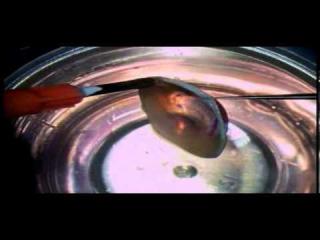When to use an ophthalmic surgical curette?
During an eye surgery, the curette is used to clean biological tissues from any fragments that could cause an infection. The curette surgical instrument is mainly used in the following types of ophthalmic surgeries :
Chalazion or eyelid cystsurgery
A chalazion is a benign affection that arises from one of the meibomian glands. Lipid inspissation in one of these glands causes the gland’s rupture and the release of lipid in the surrounding tissues. An inflammatory reaction then occurs.
If a conservative treatment doesn’t cure the chalazion, incision and curettage are performed under local anesthesia. This technique lies on the removal of the pseudo-capsule that surrounds the meibomian cyst. At the end of the surgery, a small surgical curette is used to get rid of the content of the chalazion [1].
Conjunctival concretions or eye nodules
Conjunctival concretions are a quite common asymptomatic eye affection. They are small yellow nodules located on the upper and lower eyelid palpebral conjunctiva.
Conjunctival concretions are more common in the elderly and in patients suffering chronic conjunctival inflammation.
If the patient shows some symptoms and has only a few conjunctival concretions, topical anesthesia can be performed using oxybuprocaine hydrochloride 0.4% and a sterile 25g needle.
When dozens of conjunctival concretions are observed, a curettage technique is performed using a chalazion curette. This method is carried out after an eyelid infiltration anesthesia. In addition to being safe, it usually offers good results.[2]
Eyelid molluscum contagiosum
Molluscum contagiosum are skin lesions usually located close to the eyelid margin, often leading to chronic follicular conjunctivitis. In immunocompetent patients, molluscum contagiosum can lead to some serious consequences.
This condition can be treated with curettage, using a surgical curette. This technique is usually successful and the patient doesn’t feel any pain. Use of the surgical curette is highly appreciated by surgeons in ophthalmology as, when compared to other methods, it only causes a little bleeding [3].
Evisceration procedures
Evisceration consists in the removal of the internal contents of the eye. It is usually followed by the placement of an orbital implant in replacement of the lost ocular volume.
Evisceration needs to be performed by a highly experienced surgeon as it can expose the eye to various unveil antigens. This type of surgery is usually practiced to cure penetrating ocular trauma as well as blind painful eyes. It is, however, contraindicated in case of suspected intraocular malignancy [4].
The surgical intervention can be performed under local anesthesia. A retrobulbar block is used for this purpose. In case of inflamed ocular tissues, an additional dose of anesthesia can be used.
In an evisceration procedure, the use of a surgical curette, such as the Abadie curette by Moria, is important to remove the contents of the eye. It is common to bleed during this intervention. In order to avoid the risks of sympathetic ophthalmitis, the surgeon has to check that all the black choroid has been successfully removed.
[1] Hannah Gilchrist - Management of chalazia in
general practice - RACGP.org (En Ligne) - https://www.racgp.org.au/getattachment/be67fc16-d01f-4096-a584-3fa4ab249910/Management-of-chalazia.aspx
[2] Danny Lam,corresponding author1 Elizabeth L Wong,2 Ashish Agar,2 Minas T Coroneo,2 and Ian C Francis2 - Curettage for Copious Conjunctival Concretions - National Library of Medicine (En ligne) - https://www.ncbi.nlm.nih.gov/pmc/articles/PMC7773287/
[3] Christina Scott - Molluscum Contagiosum - American Association for Pediatric Ophthalmology and Strabismus (En ligne) - https://aapos.org/glossary/molluscum-contagiosum#:~:text=Molluscum%20contagiosum%20is%20a%20common,a%20central%20crater%20(umbilication).
[4] Laura T. Phan,1,2 Thomas N. Hwang,3 and Timothy J. McCulley1,2 - Evisceration in the Modern Age - National Library of Medicine (En ligne) - https://www.ncbi.nlm.nih.gov/pmc/articles/PMC3277021/









